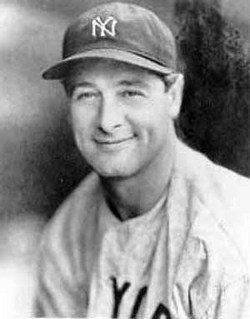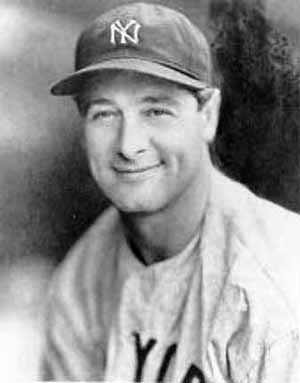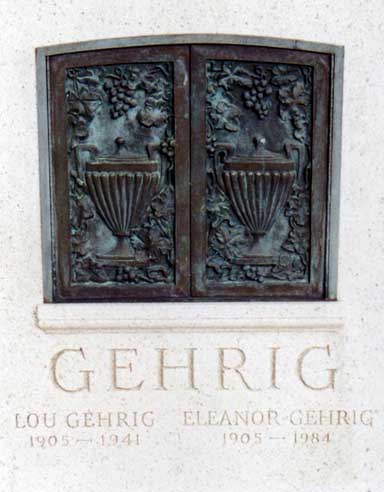Legendary baseball player. Despite his numerous baseball records, he is best remembered for his farewell speech on July 4, 1939, in Yankee Stadium, in which he said goodbye to his fans and teammates. He was elected to the Baseball Hall of Fame shortly after his retirement in 1939, and he was the first baseball player to have his Number (4 ) retired.
Born Heinrich Ludwig (Henry Louis) Gehrig in New York City to poor German immigrants, he was the only one of four children to survive to adulthood. His mother, Christina Fack Gehrig, cleaned houses and took in laundry to make ends meet, while his father, Heinrich, was in poor health due to epilepsy and was mostly unemployed. In 1921, he won a football scholarship to Columbia University, which he used to pursue an engineering degree. Gehrig played both football (fullback) and baseball (first baseman) in college, and in 1923, baseball scout Paul Krichell saw him play and was so impressed that he immediately signed him with the New York Yankees, and gave him an immediate signing bonus of $1,500, which Gehrig used to pay his sick parent's hospital bills.
In his first season, he batted .423 in his first 26 times at bat. At the end of his second year, he replaced the aging Wally Pipp at first base, where he played without missing a game for the next 13 years. Known as the "Iron Horse" for his durability, Gehrig set a record of playing in 2,130 consecutive games, which would be broken in September 1995 by Cal Ripken, Jr. Despite his talent and athletic prowess, he was mostly known for his humility, his kind heart, and his winning attitude, and he was always thankful for the opportunities that professional baseball gave him; it was this genuine and honest humbleness that endeared him to his legions of fans. He would play well every day, despite suffering common baseball injuries such as a broken thumb, a broken toe, and back spasms, which he always ignored despite the pain. When Gehrig's hands were x-rayed in the late 1930s, doctors found over 17 broken bones that had "healed" while Gehrig continued to play. His batting record was equally impressive in that he topped .300 for twelve consecutive years. Overshadowed by the equally impressive Babe Ruth, the two men would come to dominate the Yankees during the early 1930s, and despite constantly being compared by the press, they remained friends until 1933. In 1927, Gehrig was selected for the Most Valuable Player Award after the Yankees won the World Series. In 1928, Gehrig batted an outstanding .374 and tied with Ruth for runs batted in (RBIs) with 142. Yet, Gehrig's salary remained about one-third of Ruth's, tough eventually Gehrig was the first athlete to have his face on a Wheaties box.
In September 1933, he married Eleanor Twitchell, the daughter of Chicago Parks Commissioner Frank Twitchell. The competition between Ruth and Gehrig eventually boiled over due to an insult between the wives when Eleanor Gehrig made an ill comment about Claire Ruth's daughter's clothing. The two men would not speak to each other for the next six years. Ruth was traded to the Boston Braves at the end of the 1934 season, and it looked like Gehrig's time had come to be the star of the team. In 1936, a new player, Joe DiMaggio, joined the Yankees. In 1938, Gehrig's hitting and fielding deteriorated to a point far lower than his normal best. He experienced physical weaknesses and went to the Mayo Clinic for tests. Gehrig was diagnosed with Amyotrophic Lateral Sclerosis (ALS), an incurable progressive muscular degenerative disease. With a prognosis of fewer than three years left to live, the news meant the end of Gehrig's career. Sportswriter Paul Gallico suggested that the team have a Lou Gehrig Recognition Day on July 4, 1939. Speaking from his heart, Gehrig spoke his words of thanks to 62,000 fans and told them that he was "the luckiest man on the face of the earth" despite his ongoing illness. The event was considered one of the most emotional moments in sports history. At the close of his short speech, Babe Ruth put his arms around his teammate and spoke to him for the first time in six years. This special day and "luckiest man" speech were immortalized in the 1942 film "Pride of the Yankees" in with Gary Cooper starred as Gehrig.
After retiring, Gehrig worked as the New York City Parole Commissioner until ALS forced him to retire from the position. Lou Gehrig died just two years later, at age 37, at his home in Riverdale, Bronx, New York.
When his body was displayed at the Church of the Divine Paternity in Manhattan, thousands of people stood in line to view it. Babe Ruth cut ahead of everyone. As he stood in front of the casket, he wept.
Today, ALS is still sometimes referred to as Lou Gehrig's disease. His headstone lists the wrong year of birth (1905), which was erroneously inscribed at the time of his death. Kensico Cemetery is aware of this error, but they cannot make any corrections without a court order. Eleanor Gehrig never remarried; she died many years later in 1984 and was interred with her husband.
Legendary baseball player. Despite his numerous baseball records, he is best remembered for his farewell speech on July 4, 1939, in Yankee Stadium, in which he said goodbye to his fans and teammates. He was elected to the Baseball Hall of Fame shortly after his retirement in 1939, and he was the first baseball player to have his Number (4 ) retired.
Born Heinrich Ludwig (Henry Louis) Gehrig in New York City to poor German immigrants, he was the only one of four children to survive to adulthood. His mother, Christina Fack Gehrig, cleaned houses and took in laundry to make ends meet, while his father, Heinrich, was in poor health due to epilepsy and was mostly unemployed. In 1921, he won a football scholarship to Columbia University, which he used to pursue an engineering degree. Gehrig played both football (fullback) and baseball (first baseman) in college, and in 1923, baseball scout Paul Krichell saw him play and was so impressed that he immediately signed him with the New York Yankees, and gave him an immediate signing bonus of $1,500, which Gehrig used to pay his sick parent's hospital bills.
In his first season, he batted .423 in his first 26 times at bat. At the end of his second year, he replaced the aging Wally Pipp at first base, where he played without missing a game for the next 13 years. Known as the "Iron Horse" for his durability, Gehrig set a record of playing in 2,130 consecutive games, which would be broken in September 1995 by Cal Ripken, Jr. Despite his talent and athletic prowess, he was mostly known for his humility, his kind heart, and his winning attitude, and he was always thankful for the opportunities that professional baseball gave him; it was this genuine and honest humbleness that endeared him to his legions of fans. He would play well every day, despite suffering common baseball injuries such as a broken thumb, a broken toe, and back spasms, which he always ignored despite the pain. When Gehrig's hands were x-rayed in the late 1930s, doctors found over 17 broken bones that had "healed" while Gehrig continued to play. His batting record was equally impressive in that he topped .300 for twelve consecutive years. Overshadowed by the equally impressive Babe Ruth, the two men would come to dominate the Yankees during the early 1930s, and despite constantly being compared by the press, they remained friends until 1933. In 1927, Gehrig was selected for the Most Valuable Player Award after the Yankees won the World Series. In 1928, Gehrig batted an outstanding .374 and tied with Ruth for runs batted in (RBIs) with 142. Yet, Gehrig's salary remained about one-third of Ruth's, tough eventually Gehrig was the first athlete to have his face on a Wheaties box.
In September 1933, he married Eleanor Twitchell, the daughter of Chicago Parks Commissioner Frank Twitchell. The competition between Ruth and Gehrig eventually boiled over due to an insult between the wives when Eleanor Gehrig made an ill comment about Claire Ruth's daughter's clothing. The two men would not speak to each other for the next six years. Ruth was traded to the Boston Braves at the end of the 1934 season, and it looked like Gehrig's time had come to be the star of the team. In 1936, a new player, Joe DiMaggio, joined the Yankees. In 1938, Gehrig's hitting and fielding deteriorated to a point far lower than his normal best. He experienced physical weaknesses and went to the Mayo Clinic for tests. Gehrig was diagnosed with Amyotrophic Lateral Sclerosis (ALS), an incurable progressive muscular degenerative disease. With a prognosis of fewer than three years left to live, the news meant the end of Gehrig's career. Sportswriter Paul Gallico suggested that the team have a Lou Gehrig Recognition Day on July 4, 1939. Speaking from his heart, Gehrig spoke his words of thanks to 62,000 fans and told them that he was "the luckiest man on the face of the earth" despite his ongoing illness. The event was considered one of the most emotional moments in sports history. At the close of his short speech, Babe Ruth put his arms around his teammate and spoke to him for the first time in six years. This special day and "luckiest man" speech were immortalized in the 1942 film "Pride of the Yankees" in with Gary Cooper starred as Gehrig.
After retiring, Gehrig worked as the New York City Parole Commissioner until ALS forced him to retire from the position. Lou Gehrig died just two years later, at age 37, at his home in Riverdale, Bronx, New York.
When his body was displayed at the Church of the Divine Paternity in Manhattan, thousands of people stood in line to view it. Babe Ruth cut ahead of everyone. As he stood in front of the casket, he wept.
Today, ALS is still sometimes referred to as Lou Gehrig's disease. His headstone lists the wrong year of birth (1905), which was erroneously inscribed at the time of his death. Kensico Cemetery is aware of this error, but they cannot make any corrections without a court order. Eleanor Gehrig never remarried; she died many years later in 1984 and was interred with her husband.
Bio by: Kit and Morgan Benson
Gravesite Details
Lou Gehrig is buried in Kensico Cemetery in proximity to the mausoleum of Ed Barrow, who was the Yankees' General Manager during the Ruth/Gehrig era. Kensico is next door to Gate of Heaven Cemetery, where Babe Ruth and Billy Martin are buried.
Family Members
Advertisement
See more Gehrig memorials in:
Explore more
Sponsored by Ancestry
Advertisement









